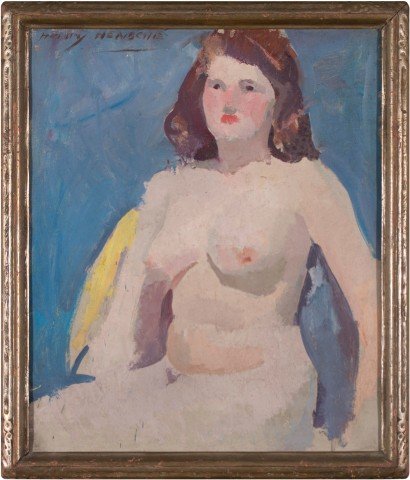Born February 25, 1899 in Germany, Henry Hensche came to the United States by way of Antwerp, Belgium. He arrived March 3, 1909 at Ellis Island aboard the British steamship S.S. Kroonland, along with his sister Erna, and his father Fred. He was 10 years old. Henry's mother died before he was two.
As a painter and teacher of consumate skill, Hensche is considered by many in the art world to be unparalleled as a fine color visualist in the "art of seeing and painting". He has been called an iconoclast, a pioneer, and the late Grand Central Art Galleries of New York named him, "L'Enfant Terrible of Academie". He is known for teaching his students how to "key" a painting.
When Henry Hensche was seventeen, he worked in the stock yards to earn the money that would send him to the Art Institute of Chicago. There he studied with tonalist George Bellows. Hensche later attended the National Academy of Fine Arts, the Art Student's League of New York, the Beaux Arts Institute of Design, and Charles Webster Hawthorne's Cape Cod School of Art. It was there in Provincetown, Massachusetts where Hensche had found his niche and calling. Just as Charles Webster Hawthorne became assistant instructor to William Merritt Chase, Henry Hensche became assistant instructor to Charles Hawthorne.
It happened to be right at the time when Hawthorne was intently involved in the study of Claude Monet and his application of color according to different light, such as Monet's series paintings. Hawthorne, nevertheless did not always implement in his commissioned paintings the knowledge he had gained from studying Claude Monet - many of Hawthorne's later works began to show his development in color. The last fifteen years of Hawthorne's life was dedicated to understanding what Claude Monet was doing in practice with the new color pigments. Henry Hensche was instrumental in taking Hawthorne's approach, "mudheads", a step further to the "color block studies", which although simple in shape, are quite effective in developing the painter's basic visual ability. The human eye can not see unless there is light on the subject it is studying. Hensche started students with sun light key, gray day key, north light key, and as one progressed, then to late afternoon light key and early morning light key and finally to the season and time of day. It is the study of the color blocks under different light conditions that give a simple reference yet continually challenge the painter's ability to see the light key and to record it accurately and effectively. Hensche devoted most of his life to this cause of developing a method of study whereby a student painter could grow visually in the understanding of color masses. As his teacher, Charles Hawthorne would say, "beauty in painting comes from putting spots of color together in a beautiful way".
After Hawthorne's death in 1930, the mantle had been passed to Henry. Mrs. Hawthorne wanted to sell the name of the Cape Cod School of Art to Henry but he refused. From 1932 to 1935 Henry taught with no name to his school. Then in summer of 1935, he began using the name, The Cape School of Art and taught in the fine Hawthorne tradition. He carried on the intense study of color, each summer until his death December 10, 1992. The schools of Hawthorne and Hensche were only open summers because the winters were too harsh for painting outdoors.
In 1974 Hensche began teaching during the winter months at Studio One in Gray, Louisiana. Between 1922 and 1930 he won the Pulitzer Traveling Prize from Columbia University and the Hallgarten Award from the National Academy of Design. He has exhibited at the Art Institute of Chicago, The Corcoran, The Philadelphia Academy of Fine Arts, and many others.
Henry Hensche is beloved by all who studied with him and his teachings and influence are evident in the work of the current Cape School style painters including Hilda Neilly, Mary Giammarino, Lois Griffel, Heather Bruce and many others.
Source: askart.com

